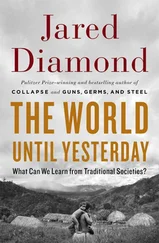Jared Diamond - The rise and fall of the third chimpanzee
Здесь есть возможность читать онлайн «Jared Diamond - The rise and fall of the third chimpanzee» весь текст электронной книги совершенно бесплатно (целиком полную версию без сокращений). В некоторых случаях можно слушать аудио, скачать через торрент в формате fb2 и присутствует краткое содержание. Год выпуска: 1991, ISBN: 1991, Издательство: RADIUS, Жанр: Биология, на английском языке. Описание произведения, (предисловие) а так же отзывы посетителей доступны на портале библиотеки ЛибКат.
- Название:The rise and fall of the third chimpanzee
- Автор:
- Издательство:RADIUS
- Жанр:
- Год:1991
- ISBN:0-09-174268-4
- Рейтинг книги:4 / 5. Голосов: 1
-
Избранное:Добавить в избранное
- Отзывы:
-
Ваша оценка:
- 80
- 1
- 2
- 3
- 4
- 5
The rise and fall of the third chimpanzee: краткое содержание, описание и аннотация
Предлагаем к чтению аннотацию, описание, краткое содержание или предисловие (зависит от того, что написал сам автор книги «The rise and fall of the third chimpanzee»). Если вы не нашли необходимую информацию о книге — напишите в комментариях, мы постараемся отыскать её.
The rise and fall of the third chimpanzee — читать онлайн бесплатно полную книгу (весь текст) целиком
Ниже представлен текст книги, разбитый по страницам. Система сохранения места последней прочитанной страницы, позволяет с удобством читать онлайн бесплатно книгу «The rise and fall of the third chimpanzee», без необходимости каждый раз заново искать на чём Вы остановились. Поставьте закладку, и сможете в любой момент перейти на страницу, на которой закончили чтение.
Интервал:
Закладка:
What makes a married person decide to seek or avoid adultery? Scientists have theories to explain many other things, so it should not be surprising that there is also a theory of extramarital sex (abbreviated to EMS, and not to be confused with premarital sex or PMS, in turn not to be confused with premenstrual syndrome, also PMS). With many species of animals the problem of EMS never arises, because they do not opt for marriage in the first place. For instance, a female Barbary macaque in heat copulates promiscuously with every adult male in her troop and averages one copulation per seventeen minutes. However, some mammals and most bird species do opt for 'marriage'. That is, a male and a female form a lasting pair-bond to devote care or protection to their joint offspring. Once there is marriage, there is also the possibility of what socio-biologists euphemistically term 'the pursuit of a mixed reproductive strategy' (abbreviated to MRS). In plain English, that means being married while simultaneously seeking extramarital sex. Married animals vary enormously in the degree to which they mix their reproductive strategies. There appears to be no recorded instance of EMS in the little apes called gibbons, while snow geese indulge regularly. Human societies similarly vary, but I suspect that none comes close to the faithful gibbons. To explain all this variation, sociobiologists have found it useful to apply the reasoning of game theory. That is, life is considered an evolutionary contest whose winners are those individuals leaving the largest number of surviving offspring. Contest rules are set by the ecology and reproductive biology of the particular species. The problem is then to figure out which strategy is most likely to win the contest: rigid fidelity, pure promiscuity, or a mixed strategy. But I must make one thing clear right at the outset. While this sociobiological approach certainly proves useful for understanding adultery in animals, its relevance for human adultery is an explosive issue and one to which I shall return. The first thing one realizes is that the best game strategy differs between males and females of the same species. This is because of two profound differences between the reproductive biology of males and females, in the minimum necessary reproductive effort, and in the risk of being cuckolded. Let's consider these differences, which are painfully familiar to humans.
For men, the minimum effort needed to sire an offspring is the act of copulation, a brief expenditure of time and energy. The man who sires a baby by one woman one day is biologically capable of siring a baby by another woman the same day. For women, however, the minimum effort consists of copulation plus pregnancy plus (throughout most of human history) several years spent nursing—a huge commitment of time and energy. Thus, a man potentially can sire far more offspring than can a woman. A nineteenth-century visitor who spent a week at the court of the Nizam of Hyderabad, a polygamous Indian potentate, reported that four of the Nizam's wives gave birth within eight days, and that nine more births were anticipated for the following week. The record lifetime number of offspring for a man is 888, sired by Emperor Moulay Ismail the Bloodthirsty of Morocco, while the corresponding record for a woman is only sixty-nine (a nineteenth-century Moscow woman specializing in triplets). Few women have topped twenty children, whereas some men easily do so in polygynous societies. As a result of this biological difference, a man stands to gain much more from EMS or polygamy than does a woman—if one's sole criterion is the number of offspring born. (To female readers about to stop reading in outrage, or to male readers about to cheer, I warn you now—keep reading, there is much more to the question of EMS.) For human EMS the statistical evidence is naturally hard to come by, but for human polygamy it is readily available. In the sole polyandrous society for which I could find data, the Tre-ba of Tibet, women with two husbands average fewer children, not more children, than women with one husband. In contrast, nineteenth-century American Mormon men realized big benefits from polygyny: men with one wife averaged only seven children, but men with two wives averaged sixteen children, and those with three wives averaged twenty. Polygynous Mormon men as a group averaged 2.4 wives and fifteen children, while polygynous Mormon church leaders in particular averaged five wives and twenty-five children. Similarly, among the polygynous Temne people of Sierra Leone, a man's average number of children increases from 1.7 to seven as his number of wives increases from one to five. The other sexual asymmetry relevant to the best game strategy involves confidence that one really is the biological parent of one's putative offspring. A cuckolded animal, deceived into rearing offspring not its own, has thereby lost the evolutionary game while advancing the victory of another player, the real parent. Barring a switch of babies in the hospital nursery, women cannot be cuckolded; they see their baby emerge from their bodies. Nor can there be cuckoldry of males in animal species practising external fertilization (that is, fertilization of eggs outside the female's body). For instance, some male fish watch a female shed eggs, then immediately deposit sperm on the eggs and scoop them up to care for them, secure in their paternity. However, men and other Wale animals practising internal fertilization—fertilization of eggs inside the female's body—can readily be cuckolded. All that the putative father knows for sure is that his sperm went into the mother, and eventually an offspring came out. Only observation of the female throughout her whole fertile period can absolutely exclude the possibility that some other male's sperm also entered and did the actual fertilizing.
An extreme solution to this simple asymmetry is the one formerly adopted by southern India's
Nayar society. Among the Nayar, women freely took many lovers simultaneously or in sequence, and husbands accordingly had no confidence in paternity. To make the best of a bad situation, a Nayar man did not live with his wife or care for his supposed children, but he instead lived with his sisters and cared for his sisters' children. At least, those nieces and nephews were sure to share one-quarter of his genes.
Bearing in mind these two basic facts of sexual asymmetry, we can now examine what is the best game strategy, and when EMS pays. Let's examine three game plans of increasing complexity:
Game Plan 1.
A man should always seek EMS, because he has so little to lose and so much to gain.
Consider the hunter-gatherer conditions prevailing throughout most of human evolution, under which a woman could at best rear about four children in the course of her life. Through one dalliance, her otherwise faithful husband could increase his lifetime reproductive output from four to five: an enormous increase of twenty-five per cent, for only a few minutes' work.
What is wrong with this dazzlingly naive reasoning?
Game Plan 2.
A moment's reflection should expose a basic flaw of Game Plan 1; it considers only the potential benefits of EMS to a man and ignores his potential costs. Obvious costs would include the risk of detection and injury or murder by the husband of the woman sought as
EMS partner; the risk that one's own wife will desert; the risk of being cuckolded by one's wife while one is off seeking EMS; and the risk that one's legitimate children will suffer through one's neglect of them. Thus, according to Game Plan 2 the would-be Casanova, like a sophisticated investor, should seek to maximize his gains while minimizing his losses. What reasoning could be more impeccably judicious?
Game Plan 3.
The man silly enough to be satisfied with Game Plan 2 has obviously never approached a lady with an offer of EMS or PMS. Worse yet, the silly man has never even thought about the statistics of human heterosexual intercourse, which dictate that, for every bout of
Читать дальшеИнтервал:
Закладка:
Похожие книги на «The rise and fall of the third chimpanzee»
Представляем Вашему вниманию похожие книги на «The rise and fall of the third chimpanzee» списком для выбора. Мы отобрали схожую по названию и смыслу литературу в надежде предоставить читателям больше вариантов отыскать новые, интересные, ещё непрочитанные произведения.
Обсуждение, отзывы о книге «The rise and fall of the third chimpanzee» и просто собственные мнения читателей. Оставьте ваши комментарии, напишите, что Вы думаете о произведении, его смысле или главных героях. Укажите что конкретно понравилось, а что нет, и почему Вы так считаете.












